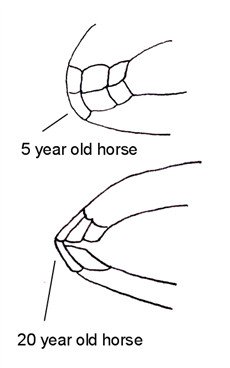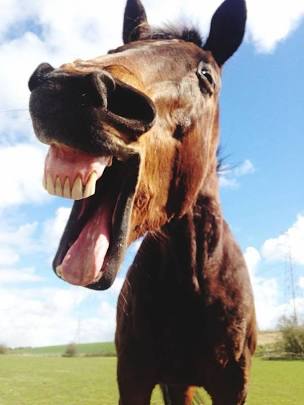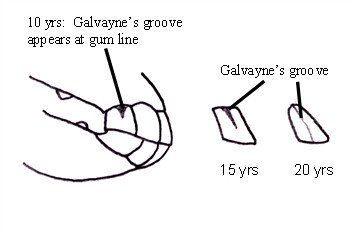Horse Teeth 2/22
Horse Teeth 2/22
Fri May 23Horse Teeth and Age
- 1 yr: have 24 baby teeth
- 2- 2½ yrs: will have second set of permanent molars
- 3 yrs: 2 permanent central incisors erupted
- 4 yrs: canine teeth erupted (males and some mares)
- 5 yrs: all permanent teeth are in, grinding surfaces are oval from side to side
- 6 yrs: permanent incisors showing wear
- 7 and 8 yrs: cups of the middle, lower incisors disappear
- 8 and 9 yrs: cups of the corner, lower incisors disappear
- 10 yrs: Galvayne’s groove appears at gum line
- 11 yrs: cups in corner, upper incisors disappear
- 12 yrs: chewing surfaces on central incisors become round instead of oval
- 14-16 yrs: corner incisors develop ridges
- 17 yrs: all incisors have round surface
- 18 yrs: central incisors become triangular
- 20 yrs: Galvayne’s groove runs the length off the corner incisors
- 23 yrs: all incisors become triangular
- 24 to 29 yrs: The grinding surfaces become oval again, but this time from front to back
- 30 yrs: Galvayne’s groove gone
- Over 30+ yrs: short teeth, small tooth nubs, loss of teet
An adult horse has 36 teeth: 12 incisors, 12 premolars and 12 molars.
A foal will have 24 teeth: 12 incisors and 12 premolars.

-
Anatomy of Horse Teeth
A horse’s tooth has a very long root that resides deep into the jaw bone. Very slowly over time tooth grows (pushes out). A very young horse will have a small bit of tooth exposed with a long root. A very old horse will have a small bit of tooth exposed with hardly any root left; as they have ‘used their tooth up’ over time.
The permanent teeth change shape as the horse grows older, because what you are seeing is the ‘root’ portion of the tooth that is slowly emerging from the jaw.
The front teeth, or incisors, are used for biting grass. The back teeth, molars and premolars, are used for grinding the grass. The horse has a large inter-dental space between the incisors and the molars. That’s a fancy term for what we call the bars, the space in the horses gums that have no teeth at all.
A young horse’s teeth will be shorter and straight up and down. The older a horse gets, the longer the tooth becomes, giving rise to the term “Long in the tooth.” The incisors become longer and more and more slanted at a forward angle as the horse ages.
Horse Teeth and the Galvayne’s Groove
At about the age of 10, the upper corner incisors begin to show a groove at the gum line. This is the Galvayne’s groove. Over the next 10 years the groove will grow all the way down the length of the tooth. A 20 year old horse will have a Galvayne’s groove all the way down the upper corner incisors.
Then the groove begins to disappear, starting from the top. By the time the horse is 30 the groove will be completely gone. Eventually those long incisors will grow very short as the old horse has very little tooth left.
| Category : | Animal Articles |
| Listing ID : | 10810 |









